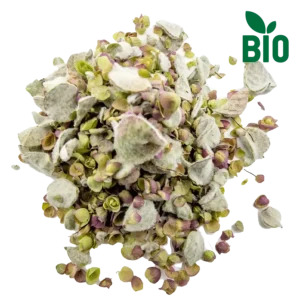Dittany for Crete is not just an endemic plant, it is a symbol that for centuries has been associated with legends, traditions, medicine, and culinary creations of the island. Depending on the area where we meet it, the locals have given it various names that sometimes refer to its characteristic areas and sometimes to its healing properties. Adichtamo, dikhtamo, ditamo, titamo, atitamo, erontas, frankincense grass, mouth grass, stagnant grass, hair grass are some of the names for the Cretan Diktamo. So let’s get to know a special Cretan herb that in antiquity was considered a “panacea”, a medicine for everything!
In the breaths of Cretan nature, among the rocks and gorges, the dittany, the famous ‘herb of the gods’, blooms. A treasure of the Cretan land, known for its rejuvenating and therapeutic properties, which from ancient times until today continues to be a symbol of well-being and natural balance.

Dittany in its full growth, is a small compact shrub, up to 30 cm tall. The leaves are characteristic, oval, and covered with dense white hair, which helps the plant to cope with drought conditions. A little secret to help us understand how much the cultivated dittany was watered during the summer, is to observe the presence of white hair-fluff. The more it is watered, the less fluff it has, while it is expected that the wild dittany has more fluff than the cultivated ones.
This beautiful compact shrub in early summer becomes even more beautiful as its inflorescences begin to grow. The initial green bracts slowly begin to acquire a striking purple-red color and later the small, light purple flowers of the plant begin to stand out. When our small shrub from green begins to acquire its wonderful colors and before its purple flowers appear it is time to collect it if we want to enjoy its unique healing properties.
In its natural environment, we find dittany growing only in Crete in steep locations with varying altitudes but preferably from 500-700 meters. The natural environment in which the dittany lives and grows is mainly the rock crevices on the northeastern slopes of Mount Dikti. It withstands low temperatures and requires well-drained soil. In the cultivation of dittany, it is especially important to choose the appropriate estate. Moisture and poor drainage of the soil cause disease and degraded product quality. Collect the entire aboveground part of the plant, leaves, and inflorescences, dry it without delay in a dark and well-ventilated area and keep it in a well-sealed container away from the sun’s rays.
Dittany was one of the plants that were definitely used during the Minoan era. Dittany seeds were found during excavations in the royal palaces of Knossos, while a depiction of the plant itself adorns patterns of pottery and murals of the time.
The name Diktamos as the ancients called it, comes from the mountain Dikti of Crete and the word shrub, that is Diktamnos = Shrub of Dikti. According to Greek mythology, the plant was dedicated to the goddess of hunting Artemis, which is why one of its names as Artemis is due. Artemis healed the wounds of those struck by arrows just like the dittany. But the Cretan goddess of childbirth, Eilithia, wore a dittany wreath on her head, a sign of her power to facilitate difficult births.
The relationship of the plant with love is closely intertwined in the Cretan tradition and apart from dittany, it is called “love”, as among other things it is considered an aphrodisiac. After all, it grows in such steep and inaccessible places on steep mountain slopes, that it gives the privilege to be collected only by those who are really in love, that is, those who are willing to risk their own lives in order to manage to cut it and offer it to their loved one. as a sign of faith and love.
The stories about the “Cretan love” are many and are passed down from generation to generation. Something that many do not know and has to do with the seeds of the dittany, is revealed when they are placed under the microscope. We were really surprised when we noticed that the very small dark-colored seeds have a heart-shaped shape, confirming in another unique way that it is a symbol of love!
From antiquity to the fourth century, we find references to the unique qualities of the Cretan Dittany in works by at least twenty-four authors. Homer, as early as the 9th century BC, reported that a bitter root was used as a remedy for gastric ulcers and bleeding, which in later times was recognized as dittany. Hippocrates (5th-4th century BC), the father of medicine, used dittany on the island of Kos, against gallbladder diseases and tuberculosis, while he was the first to say that it could cause abortion. One of the most interesting references to the medicinal power of the diktam comes from Aristotle, who stated that when the wild goats of Mount Idi (Crete) were hit by poisoned arrows, they ate aerial parts of the diktam, which resulted in forcing the arrows to leave their body and heal their wounds.
Today dittany is cultivated and exported from Crete to the whole world. Used as an essential oil, in perfumery, distillery, pharmacy, it is an excellent herbal tea and an herb that has its special place in Cretan cuisine. Its usual uses, as our grandparents taught us and passed down from generation to generation, like healing, digestive, antimicrobial, antiseptic, anthelmintic, anti-hemorrhagic, emmenagogue, antispasmodic, soothing stomach aches and relieving nausea and relief, antiepileptic properties. Dittany has been the subject of study and much modern scientific research. The main components of its essential oil (contains over 40 different ingredients with predominantly carvacrol and cumin) but also the number of flavonoids that have been isolated and identified are responsible for the medicinal properties of the plant.
One way to easily enjoy a dittany tonic drink is to prepare its infusion. In a container that can be tightly closed, place a few dried leaves and flowers. Its aroma is very intense so for a cup of drink one gram of dried herb is enough. Add hot water to the pot (temperature about 90oC just before boiling) and leave it for about 5 minutes. We choose to add water just before the boiling point so that by adding it to the herb we do not lose its volatile essential oils. Strain it and enjoy it plain, with honey, or in combination with other herbs. The particularly intense oregano aroma of the dittany is wonderfully combined with sage and Cretan mountain tea. Louisa and dittany also create a wonderful taste combination.
Dittany is undoubtedly a special case of an herb that has attracted the interest and admiration of man from antiquity to the present day. And it is truly admirable that history completes the tradition, that medicine confirms the popular belief, that the knowledge of the ancients finds application today! Dittany is a plant that due to its excessive wild collection (since the early 1900s) is now considered endangered and protected by the Treaty of Wren. The wild collection has now been banned, however, the cultivated biological areas that exist throughout the island give us the opportunity to enjoy the beneficial properties of the unique Dittany of Crete.
Our love for this herb undoubtedly influenced our course in the field of herbs. It is no coincidence that the design of our logo is influenced by the shape and size of the dittany leaf.
If you want to introduce drinking dittany tea into your daily routine then you can do it easily by picking up some of our incredible Organic Dittany of Crete tea!
Subscribe to our newsletter to stay informed about herbs, recipes, exclusive offers, and receive a 15% discount on your first order!

Ευχαριστούμε πολύ τα παρακάτω websites για τη συνδρομή τους σε επιπρόσθετο, ελεύθερο φωτογραφικό υλικό (free stock) που χρησιμοποιείται στην ιστοσελίδα μας:
Pixabay.com
Pexels.com
Unsplash.com
Freepik.com
Canva.com
Adobe.com
Σταύρος Δεβεράκης (Φωτογράφος)
Many thanks to the following websites for their subscription to additional, free stock photography used on our website:
Pixabay.com
Pexels.com
Unsplash.com
Freepik.com
Canva.com
Adobe.com
Stavros Deverakis (Photographer)